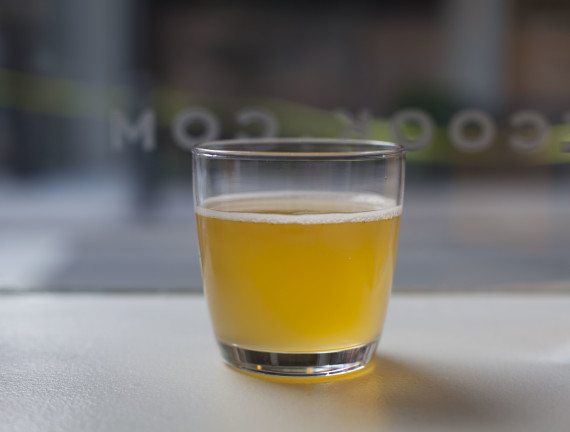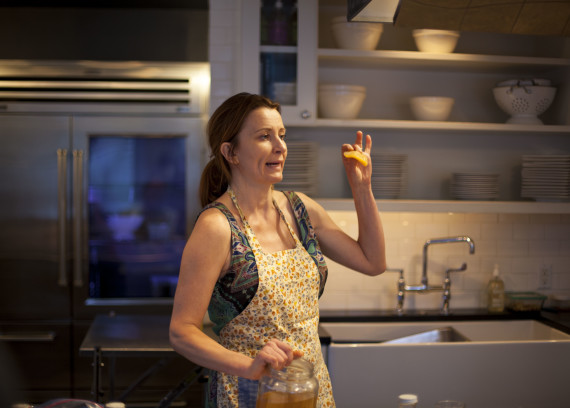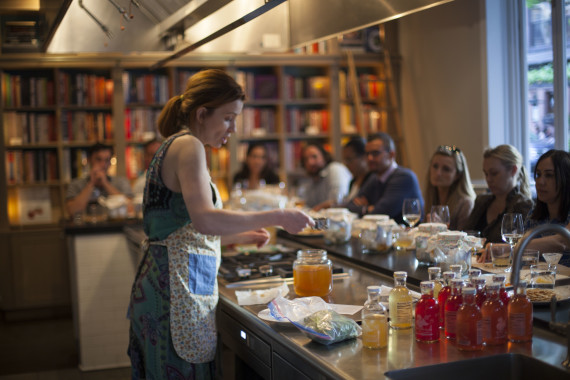Time to get cultured… kombucha cultured. Last week we had the pleasure of having Olga Sorzano of Baba’s Brew at COOK to teach people all things kombucha. Guests enjoyed some light bites of fermented foods prepared by Olga and washed it down with some gut-cleansing and delicious honey chamomile kombucha. Direct from Olga, here’s a list of 10 kombucha tips for brewing your own at home. Plus, read on for a basic kombucha recipe and get fermenting!

We all have Olga’s great grandmother (aka Baba) to thank for the refreshing kombucha that Olga is producing now. After drinking her great grandmother’s kombucha growing up in Siberia, Olga found herself craving the sweet and sour taste of her childhood. Olga then turned that craving into a thriving business: Baba’s Brew. To see where you can find West Chester-based Baba’s Brew, both in bottles and/or on tap, check out this link. For those of you in the Rittenhouse neighborhood, Di Bruno Bros. has Baba’s Brew on tap! As for those of you that want to try your hand at brewing your own kombucha, Olga shared this recipe with our guests and now you can try it yourself!
Basic Kombucha Recipe

Recipe courtesy of Olga Sorzano
Ingredients
Yields 1/2 gallon
- 1/2 gallon filtered water
- 1 tablespoon organic tea
- 1/2 cup sugar
- 1/2 cup kombucha starter
- 1 kombucha SCOBY

Olga was excited to show off the star of the show, and a key ingredient in kombucha, her SCOBY. An acronym for symbiotic culture of bacteria and yeast, the SCOBY eats most of the sugar in the tea, transforming it into a refreshingly fizzy, slightly sour fermented beverage. Good news, SCOBYs last forever, and Olga even repurposes extras as candles, fruit leather and even gummy bears!
Directions
Boil 2 cups of water in a stainless steel pot. Remove pot from heat and add loose tea. Steep for 7 minutes. Add sugar and stir until it has dissolved. Let it cool until it is about 75º – 82º F. Now pour the sweetened tea through a fine mesh strainer into your fermenting container. Add the remaining water (6 cups) and then allow to cool to room temperature. Add kombucha starter and the SCOBY to the jar with the cool sweet tea. Cover the top of your jar with cloth and secure it with a rubber band. Leave undisturbed for 7 – 10 days in a warm place, but away from direct sunlight.
After a few days sample your kombucha (daily) to determine if it is ready to drink. It should be a bit bubbly and taste both sweet and sour. If you are pleased with the taste, use clean hands to remove your SCOBY. Transfer kombucha to glass jars for storage (swing-top bottles work well), leaving about 1/2 an inch of room at the top. Allow bottled kombucha to sit at room temperature for a day or two to ferment a bit more and build up carbonation. After doing that place it in the fridge until you are ready to enjoy it!
10 Brewing Tips
- Make sure your brewing environment is room temperature. Temperature will affect the flavor of your brew.
- Use an airtight vessel to brew. This will keep out any pesky fruit flies, who can lay eggs in your kombucha! You don’t want that.
- Use filtered water. Tap water has added chlorine which will inhibit the bacterial growth in the kombucha.
- Refrigeration slows down fermentation process up to 95%.
- When flavoring your kombucha, use frozen fruit. Freezing helps break down the molecular structure of the fruit. You can let the fruit infuse your kombucha in the fridge for up to 24 hours, but then be sure to strain out the fruit or it will get slimy and discolored.
- Stainless steel, bamboo, and silicon utensils are safe to use with your kombucha. Don’t use plastic or aluminum.
- After 48 hours you will start to see growth. After 72 hours it becomes thicker in appearance. After 8 – 10 days there will be SCOBY on top.
- Don’t worry if your SCOBY floats or sinks, both are fine!
- If you want to “burp” your bottle to release some carbonation, do it over the sink so you don’t have a mess on your hands – in extreme cases, it can fizz over or spray upwards.
- The longer you ferment the kombucha, the less sugar it will have, therefore it will be more tart. So if you would like a sweeter bucha simply shorten your brew.




